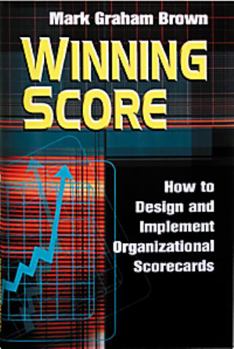Winning Score: How to Design and Implement Winning Scorecards
Select Format
Select Condition 
Book Overview
Now in Paperback Highlighted with valuable tips and Brown's firsthand experiences, Winning Score is an excellent tool for constructing a performance measurement system. It explains how to lay the... This description may be from another edition of this product.
Format:Hardcover
Language:English
ISBN:1563272237
ISBN13:9781563272233
Release Date:September 2000
Publisher:Productivity Press
Length:336 Pages
Weight:1.26 lbs.
Dimensions:0.9" x 6.2" x 9.3"
Customer Reviews
3 ratings
A wonderful resource
Published by Thriftbooks.com User , 20 years ago
Mark Graham Brown has produced another useful, direct, and informative business book. I found the checklists and interview questions especially helpful in my executive coaching and consulting practice. A couple of clients dampened my enthusiasm with concerns over terminology and level of sophistication for implementation, but the material actually helped me to pinpoint their concerns and address their questions. If you're doing Scorecards, get this book.
First Ask: Are You Competing in the Right Game?
Published by Thriftbooks.com User , 23 years ago
Zarate has written an first-rate review of this excellent book but may unintentionally suggest that the value of the book will be greatest for "mature" organizations when, in fact, small-to-midsize organizations also have an urgent need to "design and implement scorecards" by which to obtain accurate measurements of various kinds. My own opinion is that their need is indeed greater because they have fewer resources available and narrower margins for error. Therefore, organizational waste and incompetence can have much greater impact. Aphorisms which endure express an essential truth. For example, "You can't manage what you can't measure." There may be some exceptions but not many. What Brown accomplishes in this book is to provide and then explain a cohesive, comprehensive, and cost-effective system which accommodates most organizations' needs for operational metrics and plans, for strategic metrics and plans, and then for implementation of the "scoreboard" after it has been devised. He identifies ten "Mistakes" which create barriers to addressing these separate but related needs:1. Tracking output/outcome metrics that cannot be influenced or controlled2. Gathering data that tells you what you already know3. Gathering data for its own sakeNOTE: Brown and I apparently disagree about "data" which I consider a plural.4. Relying heavily [too heavily] on customer satisfaction surveys5. Executives focusing on detailed metrics6. Measures that are not linked to the strategic planNOTE: Kaplan and Norton have much of great value to said about this in their most recent book, The Strategy-Focused Organization: How Balanced Scorecard Companies Thrive in the New Business Environment7. Failing to define Practical Correlations between [and among] key metrics8. Reporting data that is difficult to read and analyze9. "Superstitious" process metrics10. Measures that drive the wrong performanceBrown explains how and why such "Mistakes" are made, how to correct them, and also how to avoid repeating them. For purposes of illustration, let's say your organization needs to improve performance in these three areas: Cycle Time, First Pass Yield, and On-Time Delivery. Although separate, they are also interdependent. Obviously there are problems which need to be solved. More often than not, a corrective action responds to symptoms rather than to root causes. We all know that many (most?) of those involved in any organizational process (regardless of nature and extent) fear change, resent what they perceive to be criticism of their performance, and will therefore resist (perhaps sabotage) efforts to transform the status quo. Hence the importance of formulating the correct metrics, applying them where they will generate the data needed, and -- meanwhile -- ensuring that the "score" kept is appropriate to whatever "game" is being played.
Essential for mature organizations
Published by Thriftbooks.com User , 23 years ago
This book goes a long way towards helping organizations actually implement balanced scorecards instead of giving them lip service. It also shows what to measure and why, and gives a list of measurement mistakes that render many company's balanced scorecard efforts meaningless.Unlike Kaplan's and Norton's seminal (and decade old) book, "The Balanced Scorecard", this book is short on theory and heavy on practical applications. This is not a criticism of "The Balanced Scorecard" - just recognition of the fact that in the ensuing decade since that book was first published there have been lesson's learned about what does and does not work. The author distills these lesson's learned into this slim, content-filled book.What I like most is the author clearly links metrics to vision, mission and strategy. This is what a balanced scorecard is supposed to be about, but this is not always so in practice. He also sorts out the difference between basic business indicators and critical success factors, which is augmented by an outstanding discussion (throughout the book) on top measurement mistakes, and a liberal sprinkling of tips throughout the book.Probably the most valuable parts of the book are Part 3, where step-by-step procedures are given to implement an *effective* scorecard, and the appendices which contain case studies drawn from real organizations and actual scorecards. The examples given are worth their weight in gold and elevate this book from the theoretical to realistic and practical. My highest recommendation and 5 solid stars.






